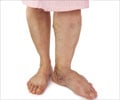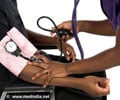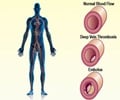A blood clot in the deep venous system of the leg leads to deep vein thrombosis (DVT), which is a major cause of morbidity and mortality, especially in hospitalized and surgical patients whose movement is restricted.
Find out your probability and risk for Deep Vein Thrombosis and the treatment options that are available.
Note:Please enable javascript in your browser to view the results.
Reference
This calculator has been modeled based on the article 'Value of assessment of pretest probability of deep-vein thrombosis in clinical management' The Lancet, Volume 350, Issue 9094, Pages 1795 - 1798, 20 December 1997doi:10.1016/S0140-6736(97)08140-3 Advertisement
Recommended Readings on Deep Vein Thrombosis
Did you know that prolonged sitting can cause a blood clot? Or if that clot stuck in the lungs death ensues? Learn more about deep vein thrombosis from this ...
Blood pressure is the pressure of the blood flowing through your blood vessels against the vessel walls. Just by entering you age, you can get the accurate range of blood pressure value.
Bleeding disorder is an acquired or an inherited condition, which is characterized by excessive bleeding in the persons affected by the problem.
Pulmonary embolism (PE) is a complication that results from a block in the main artery supplying the lungs
Flash presentation on radiofrequency ablation (RFA) or laser ablation, used in the treatment of dilated and tortuous varicose veins, commonly found in the lower extremities.
Varicose vein is caused by swelling, twisting of vein that may lead to pain. It is commonly seen in calf, ankle and legs.
Deep vein thrombosis or DVT can occur in cases of prolonged immobility like sitting in a cramped seat during long haul
flights lasting over 4 hours.
A blood clot (thrombus) in the deep venous system of the leg leads to deep vein thrombosis (DVT). DVT is a major cause of morbidity and mortality.







